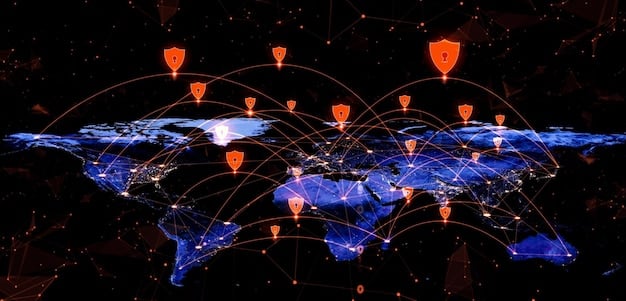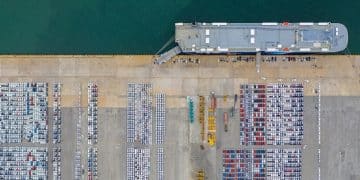US Supply Chain Resilience: Mitigating Global Disruptions

Navigating the intricate landscape of global trade, US supply chain resilience hinges on strategic foresight and adaptive innovation, fundamentally mitigating the profound impacts of ongoing worldwide disruptions.
In a world characterized by unprecedented interconnectedness, the stability of the US economy is increasingly tethered to the robustness of its supply chains. The concept of US Supply Chain Resilience: Strategies for Mitigating the Impact of Ongoing Global Disruptions has transcended theoretical discussion to become a paramount imperative, influencing national security, economic stability, and everyday consumer access to goods.
Understanding the Evolving Landscape of Global Disruptions
The global supply chain, once perceived as a finely tuned machine, has revealed its inherent vulnerabilities in recent years. From geopolitical tensions and trade wars to pandemics and natural disasters, the frequency and intensity of disruptions have surged, fundamentally altering how businesses and governments perceive risk.
These disruptions are no longer isolated incidents but rather complex, multi-faceted challenges that cascade across continents. Understanding their nature and potential impact is the first critical step toward building genuine resilience. It requires a nuanced appreciation of both immediate shocks and underlying systemic vulnerabilities.
Types of Disruptions Affecting US Supply Chains
Identifying the varied forms of disruption is crucial for targeted mitigation strategies. Each type presents unique challenges and demands specific responses. The interplay between these disruptions often amplifies their collective impact, creating a need for flexible and adaptable systems.
- Geopolitical and Trade Policy Shifts: Imposition of tariffs, trade embargoes, and changing international relations can re-route supply networks, increase costs, and limit access to critical components.
- Natural Disasters and Climate Change: Extreme weather events, such as hurricanes, floods, and droughts, directly impact production facilities, transportation infrastructure, and agricultural output.
- Public Health Crises: Pandemics like COVID-19 demonstrated the devastating effects of widespread labor shortages, factory shutdowns, and cross-border movement restrictions.
- Cybersecurity Threats: Increasingly sophisticated cyberattacks can cripple logistics systems, manufacturing operations, and data integrity, leading to profound operational disruptions.
The lessons learned from these events underscore the urgent need for a more proactive and predictive approach to supply chain management. Sole reliance on efficiency, while valuable, must now be balanced with a robust capacity for adaptation and recovery.
Key Pillars of US Supply Chain Resilience Strategy
Building a resilient supply chain is not merely about reacting to crises; it involves proactively embedding strength and adaptability into its very fabric. This shift requires a multi-pronged approach that addresses vulnerabilities at various levels, from sourcing to delivery. It moves beyond just-in-time models to incorporate just-in-case contingencies.
The foundational pillars for enhancing US supply chain resilience emphasize diversification, technological adoption, and collaborative ecosystems. These elements, when integrated effectively, create a robust framework capable of withstanding severe shocks and recovering swiftly.
Diversification of Sourcing and Manufacturing
Over-reliance on a single geographic region or supplier has proven to be a significant Achilles’ heel. Diversification strategies aim to spread risk by increasing the number of suppliers and manufacturing locations, both domestically and internationally. This “friendshoring” or “nearshoring” approach reduces dependency on volatile regions and improves responsiveness.
- Multi-Region Sourcing: Establishing supplier relationships in diverse geographical areas mitigates the impact of localized disruptions, such as natural disasters or political instabilities.
- Domestic Production Enhancement: Investing in and incentivizing American manufacturing capabilities reduces reliance on overseas production, particularly for critical goods and components. This also strengthens domestic job markets.
- Inventory Optimization: While not a return to excessive stockpiling, strategic inventory buffers for critical items can provide a crucial time cushion during supply interruptions.
This strategic shift away from hyper-concentration requires careful analysis of cost, quality, and risk, ensuring that diversification doesn’t inadvertently introduce new vulnerabilities or significant inefficiencies.
Technological Adoption and Digital Transformation
Technology serves as a powerful enabler for supply chain resilience, offering unprecedented visibility, predictive capabilities, and automation. Digital transformation moves beyond simple data collection to actionable insights, allowing for quicker decision-making and more adaptive responses.
Artificial intelligence, machine learning, and blockchain are no longer futuristic concepts but practical tools that can revolutionize supply chain management. Their integration allows for real-time monitoring, demand forecasting, and tracing of goods, fundamentally improving transparency and accountability across the network.
- AI-Powered Forecasting and Analytics: Advanced algorithms can predict disruptions, analyze demand fluctuations, and optimize inventory levels with greater accuracy than traditional methods.
- Blockchain for Transparency: Distributed ledger technology provides an immutable and transparent record of transactions, enhancing traceability, combating counterfeiting, and improving trust among supply chain partners.
- IoT and Real-Time Monitoring: Sensors and connected devices provide live data on product location, environmental conditions, and equipment status, enabling proactive interventions and reducing delays.
Embracing digital twins and advanced simulation models can also help organizations test hypothetical scenarios, identify weak points, and refine their resilience strategies without disrupting actual operations.

Governmental and Policy Frameworks for Resilience
While industry initiatives are vital, governmental intervention plays a crucial role in shaping the environment for supply chain resilience. Policy frameworks can incentivize desired behaviors, direct investments, and establish critical infrastructure necessary for a robust national supply chain.
Recent legislative efforts in the U.S. highlight a growing recognition of this imperative, aiming to fortify key strategic sectors. Coordinated governmental action can address systemic issues that individual companies might find difficult to tackle alone, such as rare earth mineral sourcing or semiconductor manufacturing.
Strategic Stockpiling and Reserves
For essential goods and critical components, maintaining strategic national reserves can provide a vital buffer against sudden supply shocks. This goes beyond traditional national defense stockpiles to include medical supplies, semiconductors, and other items deemed crucial for economic stability and national security.
The process involves identifying critical vulnerabilities, assessing potential shortages, and developing procurement and storage mechanisms to ensure availability during emergencies. It is a counterbalance to the efficiency-driven trend of minimal inventory.
Incentivizing Domestic Production and Reshoring
Government policies can play a significant role in encouraging companies to bring manufacturing capabilities back to the United States or to establish new domestic production sites. This can include tax breaks, subsidies, grants, and streamlined regulatory processes.
Legislation such as the CHIPS and Science Act aims to bolster domestic semiconductor manufacturing, recognizing its strategic importance. Similar initiatives are being explored for pharmaceuticals, critical minerals, and renewable energy components, all designed to reduce foreign dependencies.
International Cooperation and Supply Chain Alliances
Given the inherently global nature of supply chains, international collaboration is indispensable. Building alliances with trusted trading partners can diversify sourcing options, establish shared standards, and facilitate coordinated responses to global disruptions.
This includes working with allies on raw material access, standardizing digital infrastructure, and developing multilateral agreements that promote free and fair trade while discouraging coercive economic practices. Such cooperation enhances collective resilience and reduces the likelihood of future shocks.
Industry-Specific Resilience Strategies
While overarching strategies apply broadly, certain sectors face unique challenges and require tailored approaches for supply chain resilience. The methodologies employed by the automotive industry, for example, may differ significantly from those used in healthcare or food production.
Understanding these nuances allows for more precise and effective interventions. Each industry must assess its specific vulnerabilities, from dependence on particular raw materials to specialized transportation needs, and develop bespoke resilience plans.
Healthcare and Pharmaceutical Supply Chains
The COVID-19 pandemic exposed profound frailties in the healthcare supply chain, from personal protective equipment (PPE) to essential medicines. Resilience in this sector is literally a matter of life and death, demanding stringent standards and diversified access.
Strategies include maintaining robust domestic manufacturing capabilities for critical drugs, investing in advanced analytics for demand forecasting, and establishing clear protocols for activating emergency supply routes. Serialization and traceability technologies are also key for ensuring authenticity and preventing counterfeiting.
High-Tech and Semiconductor Supply Chains
The global reliance on semiconductors underscores the fragility of this complex supply chain, which involves highly specialized manufacturing processes and a limited number of advanced fabs. Disruptions here can have cascading effects across numerous industries, from consumer electronics to defense systems.
Building resilience involves significant long-term investments in domestic R&D and fabrication plants, fostering a skilled workforce, and securing access to essential raw materials. Collaborative efforts with international partners to diversify manufacturing hubs are also paramount to mitigate single points of failure.
Food and Agriculture Supply Chains
Ensuring food security requires a highly adaptable and resilient agricultural supply chain, susceptible to climate change, geopolitical events, and disease outbreaks. The sheer volume and perishable nature of agricultural products add layers of complexity.
Strategies focus on diversifying crop sources, investing in climate-resilient farming practices, improving cold chain logistics, and strengthening local and regional food systems. Early warning systems for crop diseases or pest outbreaks are also critical to preventing widespread losses.
Challenges and Future Outlook for US Supply Chain Resilience
Despite significant progress and heightened awareness, the journey toward comprehensive US supply chain resilience is fraught with challenges. Balancing efficiency with robustness, managing the costs associated with increased redundancy, and adapting to ever-evolving threats are ongoing tasks.
The future of US supply chain resilience will likely be defined by continuous adaptation, leveraging emerging technologies, and fostering a culture of proactive risk management. It is not a destination but an iterative process of improvement and strategic adjustment.
Balancing Efficiency and Resiliency Costs
Historically, supply chains prioritized lean, just-in-time models for maximum efficiency and cost reduction. Building resilience often involves investments in redundant capacities, diversified sourcing, and higher inventory levels, which can inherently increase costs.
The challenge lies in finding the optimal balance where acceptable levels of risk are offset by strategic investments, without unduly burdening businesses or consumers. This requires sophisticated cost-benefit analyses that factor in the long-term economic and security benefits of resilience versus short-term efficiency gains.
Workforce Development and Skilled Labor Gaps
A resilient supply chain depends on a skilled workforce capable of operating advanced technologies, managing complex logistics, and adapting to new processes. Shortages of truck drivers, logistics managers, data scientists, and skilled manufacturing technicians pose significant challenges.
Addressing these gaps requires coordinated efforts in education, vocational training, and workforce development programs. Investing in STEM education and promoting careers in logistics and manufacturing are crucial for developing the talent pipeline needed to support a resilient supply chain ecosystem.

The Role of Data and Analytics in Proactive Risk Management
In an increasingly complex global environment, the ability to anticipate and respond to disruptions before they escalate is paramount. Data and advanced analytics represent a cornerstone of proactive risk management within supply chains. They enable organizations to move beyond reactive measures to predictive and prescriptive strategies.
By leveraging vast amounts of historical and real-time data, businesses can gain unparalleled insights into potential vulnerabilities, optimize resource allocation, and simulate various disruption scenarios. This data-driven approach fosters a more agile and prepared supply chain network.
Enhanced Visibility and Transparency
Visibility refers to the ability to track goods, materials, and information across the entire supply chain, from raw material extraction to final delivery. Transparent data flows allow companies to identify bottlenecks, monitor supplier performance, and detect anomalies in real-time. This level of insight is critical for rapid decision-making when disruptions occur.
Implementing sophisticated tracking systems, such as RFID and GPS, integrated with enterprise resource planning (ERP) systems, provides a comprehensive overview of operations. This granular data enables precise interventions and reduces the risk of undetected issues festering into major problems.
Predictive Risk Forecasting
Harnessing the power of machine learning and artificial intelligence, organizations can develop predictive models that forecast potential disruptions. These models analyze a multitude of factors, including weather patterns, geopolitical instability indicators, economic data, and social trends, to identify emerging risks.
For example, AI algorithms can predict supply shortages based on unusual order patterns, assess the likelihood of transportation delays due to severe weather fronts, or flag potential supplier solvency issues. Such foresightedness allows for the activation of contingency plans well in advance, minimizing impact.
Scenario Planning and Simulation
Advanced analytical tools facilitate the creation of digital twins and simulation models of entire supply chains. This enables companies to run “what-if” scenarios, testing the impact of various disruptions—from port closures to cyberattacks—without affecting actual operations.
By simulating multiple outcomes, businesses can evaluate the effectiveness of different resilience strategies, identify critical single points of failure, and optimize their response plans. This proactive simulation builds organizational muscle memory for crisis management and fine-tunes readiness protocols.
Fostering Collaboration and Information Sharing
No single entity, whether a company or a government agency, can achieve complete supply chain resilience in isolation. The interconnectedness of global trade necessitates a collaborative approach where information sharing and partnerships are paramount. Breaking down silos and building trust across the ecosystem are vital for mutual benefit and collective strength.
This collaborative spirit extends from direct supplier relationships to broader industry consortia and public-private partnerships. The goal is to build a web of interconnected capabilities that can collectively absorb shocks and accelerate recovery.
Strengthening Supplier Relationships
Beyond transactional interactions, building deep, collaborative relationships with key suppliers is fundamental. This means sharing demand forecasts, collaborating on risk assessments, and even jointly investing in resilience-building initiatives. Long-term partnerships based on trust foster greater transparency and mutual support during times of crisis.
Implementing supplier diversification also requires robust communication channels to manage multiple relationships effectively. Regular audits, shared performance metrics, and joint problem-solving mechanisms contribute to a more robust supplier network.
Industry Consortia and Best Practice Sharing
Across various sectors, industry associations and consortia can serve as vital platforms for sharing best practices, conducting joint research on emerging threats, and developing common standards for resilience. This collective intelligence strengthens the entire industry by disseminating knowledge and promoting adoption of effective strategies.
Such forums can also lobby for favorable policy frameworks, share insights on regional risks, and coordinate efforts to address systemic vulnerabilities that impact multiple companies within a sector. Collaborative initiatives can lead to more resilient industry-wide solutions.
Public-Private Partnerships
The most significant challenges to supply chain resilience often require cooperation between government entities and private businesses. Public-private partnerships (PPPs) can facilitate the sharing of threat intelligence, coordinate emergency responses, and co-invest in critical infrastructure or strategic stockpiles.
For example, governments can provide incentives for reshoring critical manufacturing, while private companies contribute their operational expertise and investment capital. These partnerships leverage the unique strengths of both sectors to achieve shared resilience goals, particularly for items of national strategic importance.
| Key Strategy | Brief Description |
|---|---|
| 🌍 Diversification | Spreading manufacturing and sourcing across multiple regions to reduce dependency. |
| 💡 Tech Adoption | Utilizing AI, IoT, and blockchain for enhanced visibility and predictive analytics. |
| 🤝 Collaboration | Fostering stronger relationships with suppliers, industry peers, and government bodies. |
| ⚖️ Policy Support | Government incentives and strategic stockpiling to safeguard critical sectors. |
Frequently Asked Questions
▼
US supply chain resilience refers to the ability of American supply networks to anticipate, withstand, and recover from disruptive events. This involves developing strategies like diversification of sourcing, technological adoption, and robust policy frameworks to minimize the impact of global disruptions on economic stability and continuity.
▼
Diversification is critical because it reduces over-reliance on single suppliers or geographic regions. If one source is disrupted by natural disasters, geopolitical issues, or other crises, having alternative sources in different locations ensures continuity of supply, mitigating risk and maintaining economic stability and consumer access to goods.
▼
Technology, including AI, machine learning, IoT, and blockchain, significantly enhances resilience by providing real-time visibility, predictive analytics, and automation. These tools allow for better demand forecasting, proactive risk identification, improved traceability, and optimized inventory management, leading to faster and more informed decision-making during disruptions.
▼
Government policies are crucial for fostering US supply chain resilience through various means. They can offer incentives for domestic production, develop strategic stockpiles of critical goods, facilitate international cooperation, and invest in infrastructure. These policy frameworks create an environment that supports and strengthens national supply chain capabilities, reducing vulnerabilities.
▼
Key challenges include balancing the increased costs associated with building redundancy and diversification against the traditional drive for efficiency. Additionally, addressing skilled labor shortages, managing complex geopolitical shifts, and continuously adapting to new forms of disruption are ongoing challenges that require strategic and collaborative efforts.
Conclusion
The journey toward robust US Supply Chain Resilience: Strategies for Mitigating the Impact of Ongoing Global Disruptions is a continuous and multifaceted endeavor that demands a holistic approach. It transcends mere operational efficiency, embracing long-term strategic investments in diversification, technological innovation, and collaborative ecosystems. While challenges persist, the lessons gleaned from recent global disruptions have galvanized a collective resolve across government and industry to fortify these vital networks. A resilient future for the US economy and its citizens hinges on proactive foresight, adaptable strategies, and a steadfast commitment to building supply chains that can withstand the unpredictable currents of a globalized world.





